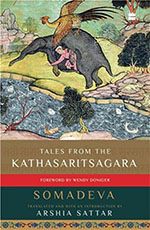The opening lines of many books have acquired iconic status. From Dickens to Daphne du Maurier, the first lines have entranced the reader, and brought him back to the book time and again. Of all these, few can match the effectiveness of the first line in its simplest form ‘Can I tell you a story?’ or ‘Once upon a time….’ In an instant, the imagination is captured; we want to know ‘What comes next?’
A story well told holds universal fascination. The Kathasaritsagara is a prime example of a timeless work. As with the epics of India, most of us are accustomed to hearing these tales from childhood. Said to have been compiled by Somadeva in the time of Ananta in the eleventh century it is part magical tales, part human stories, part epic and part history. Where it differs from most other major works from India is that it does not contain any religious teaching. It can be argued that this like the Kural is a secular text, a great example of the intellectual and cultural wealth of our country.
The work contains over 20,000 verses, more than 350 tales. It is, to quote one of the early descriptions in English ‘an ocean full of stories of every conceivable description—tales of wondrous maidens and their fearless lovers, of kings and cities, of statecraft and intrigue, of magic and spells, of treachery, trickery, murder and war, tales of blood-sucking vampires, devils, goblins and ghouls, stories of animals, in fact and fable, and stories too of beggars, ascetics, drunkards, gamblers, prostitutes and bawds.’
Continue reading this review

